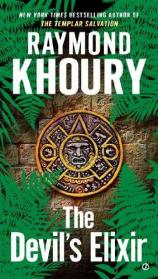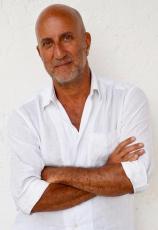Interview: December 15, 2011
Raymond Khoury’s THE DEVIL’S ELIXIR marks the return of FBI agent Sean Reilly and his girlfriend, Tess Chaykin, who now find themselves in a deadly race against time to trace the long history of a secret, dangerously powerful drug. In this interview, conducted by Bookreporter.com’s Ray Palen, Khoury shares his research and opinions of the “war on drugs” in the United States and Mexico, describes the process of writing in the first person for the first time, and gives a glimpse into two planned sequels.
Bookreporter.com: All of your previous novels have been historical thrillers. THE DEVIL'S ELIXIR is far more of a crime drama with a touch of the metaphysical. Was this a natural progression or a conscious choice?
Raymond Khoury: A bit of both, really. This book could easily have had a historical McGuffin in the form of a “long lost secret” that people are after today and had several historical chapters in it as I’ve had in all my previous novels apart from THE SIGN. It would’ve been really easy (and fun) to build Eusebio’s story into a multi-chapter adventure in itself. But as I started to write it, several things happened: I felt I really needed to try something new, and I decided this book had to be a first-person narrative, from Reilly’s point of view, since the story was so intense and personal to him; and when I did that, it really felt fresh and exciting to me to tell it more like a crime drama. I didn’t want to spend any time away from Reilly’s story and cut away to a parallel historical tale, and I’m thrilled with the result.
BRC: What personal beliefs or supernatural topics inspired you to add a metaphysical plot element to THE DEVIL'S ELIXIR?
RK: As with all my books, this one started with a “big theme” I wanted to research and know more about, a “big question” about life and the hereafter that I think we all wonder about at one point or another. It’s something I’ve always been curious about, ever since I was a kid. I wanted to know what we really know about that, rationally, scientifically --- what research there is about it. That was the key trigger to writing the book, and the story grew out of that question.
BRC: How much of the current U.S. war on drugs and Mexican drug cartels played a part in your ideas for THE DEVIL’S ELIXIR?
RK: The “War on Drugs” was a big part of writing this book, especially in terms of what’s been happening in Mexico, which is so tragic --- an entire nation with so much history and so much natural beauty, so much to offer, ravaged by savage drug cartels and a misguided drug policy. This devastating “prohibition” has been a huge mistake and a huge failure --- everyone knows it --- and although there is no easy answer, it’s clear a new approach is needed. Sadly, no one in D.C. has the guts to open up a frank and pragmatic discussion about how to deal with it.
BRC: Sean Reilly and Tess Chaykin have never been afraid to show their flaws. However, a seriously bad moral decision by Sean comes back to haunt him in this novel. Do you believe he redeemed himself by the end, or will this weigh on his conscience in future novels?
RK: I think Reilly redeemed himself as much as he possibly can, but given his nature, I think it will always weigh on his conscience, as will the other losses that he will have suffered during this book.
BRC: The narrative in THE LAST TEMPLAR and THE TEMPLAR SALVATION was told in third-person point-of-view. This time, Reilly's story is in first-person narrative. Why did you make this change? And what was it like writing in a different voice like that?
RK: I was actually going to write this book after THE SIGN, and not with Reilly in mind. I was researching the theme at its core when the idea for THE TEMPLAR SALVATION came to me out of the blue, and I really felt like writing that first and having some fun with Reilly and Tess again now that enough time had passed since the first book. Then when I came back to THE DEVIL’S ELIXIR with Reilly refreshed and very present in my mind, I realised this story would suit him perfectly, but after writing the first 80 pages or so in third person, something was missing. Then it just hit me: it had to be in first person. I’d never written in first person. This was new to me, so I tried it, and over a weekend I went back and re-wrote those pages. And it just burst to life in a totally unexpected way, so much so that I just raced through the rest of the book at warp speed. I totally loved writing in the first person --- it allowed me to get into Reilly’s skin much more, especially given everything that happens to him in this story. In fact, the next two books (at least) will build on this.
BRC: Raoul Navarro (aka El Brujo) may be the most sinister villain you have written. Who or what inspired this character?
RK: I love my villains: the Bullet (in THE SIGN), Zahed (in THE TEMPLAR SALVATION), and, of course, the hakeem (from THE SANCTUARY), who was the most sinister pre-Navarro, I think. Navarro had to be more than just a drug kingpin; I wanted him to have a spiritual side, a Santero cult-ish shaman witch-doctor aspect that made him far more terrifying. And the more I researched esoteric hallucinogens and rituals, the more it seemed like everything I wanted him to be wasn’t that much of a stretch of the imagination.
BRC: In THE DEVIL'S ELIXIR, it is stated: "Raoul Navarro grew up believing that magic existed." Do you view this as a character flaw or an impetus for his eventual evil choices?
RK: Navarro was lucky to believe in magic, especially given the tragic circumstances he grew up in that, sadly, aren’t that hard to come across in certain parts of Mexico, where drugs are an intrinsic part of life. But he reaches a crossroad where his life could have gone either way, and he chooses to take the dark path (a choice that’s influenced by his drug experimentation), and everything spirals from there.
BRC: Four-year-old Alex plays a key role here. How different is it to write children as major characters in a mostly adult thriller?
RK: A bit daunting, but a lot of fun, actually. I got to spend some time with some friends who have four-year-olds (my kids are older now) and enjoyed rediscovering how they talk, think, draw, what they play and watch on TV --- and how easily they can work an iPad! It was great.
BRC: What other age-old mysteries interest you, and will they eventually become the backdrop for future novels?
RK: Right now, I think I’m more interested in intriguing concepts that can be the backbone of present-day crime-thrillers, more than historical mysteries per se. I really don’t read historical fiction at all anymore, I think I’ve grown tired of it. My next book is about mind control and brainwashing, and although I’ve set its roots in the early 1900s, in a political upheaval that changed the world, it’s not a historical mystery. It’s more like “speculative fiction with a historical root,” if that doesn’t sound too convoluted!
BRC: There was a made-for-TV movie of your debut novel, THE LAST TEMPLAR, starring Mira Sorvino. Are there any plans for additional film scripts of your work?
RK: At the moment, some producers in L.A. are casting an old screenplay of mine called BLOODLINE, which isn’t a novel (it’s a near-future thriller). I’m not keen to explore more TV movies, as I wasn’t a fan of the TEMPLAR adaptation at all (I only ever watched the first 10 minutes of it). But calls are starting to come in about THE DEVIL’S ELIXIR, which I think would make a terrific movie and would love to see on a big screen.
BRC: What's next for Sean Reilly and Tess Chaykin?
RK: At least two more books, in first person from Reilly’s point of view, stories that will have subtle links back to THE DEVIL’S ELIXIR (the clue is in the last chapter). After that, who knows!
BRC: What are you working on now, and when might readers expect to see it?
RK: The novel I referred to earlier, which will come out in a year’s time, towards the end of 2012.




